IT'S MARIO KART WORLD, WE'RE JUST LIVING IN IT
after what feels like an entire console's lifespan worth of false starts and OLED models, the real, actual, 'full of better guts for better games' Nintendo Switch 2 is upon us, and with it, a new Mario Kart to usher in the new system. a lot's been said about the rather lofty price tags attached to this console and its games, but i'm grateful to be in a position where i was able to split the cost, and i do treat that as quite the privilege. as i've fiddled around with Mario Kart World, i've found myself having a few thoughts that might feel like they're worth jotting down for my own amusement, but the more i think about it, the more i realize i might actually be able to convey some stuff about this game to friends who might be unable to make the jump to Switch 2, or who may be on the fence about such a big commitment. something, something, great responsibility, etcetera.
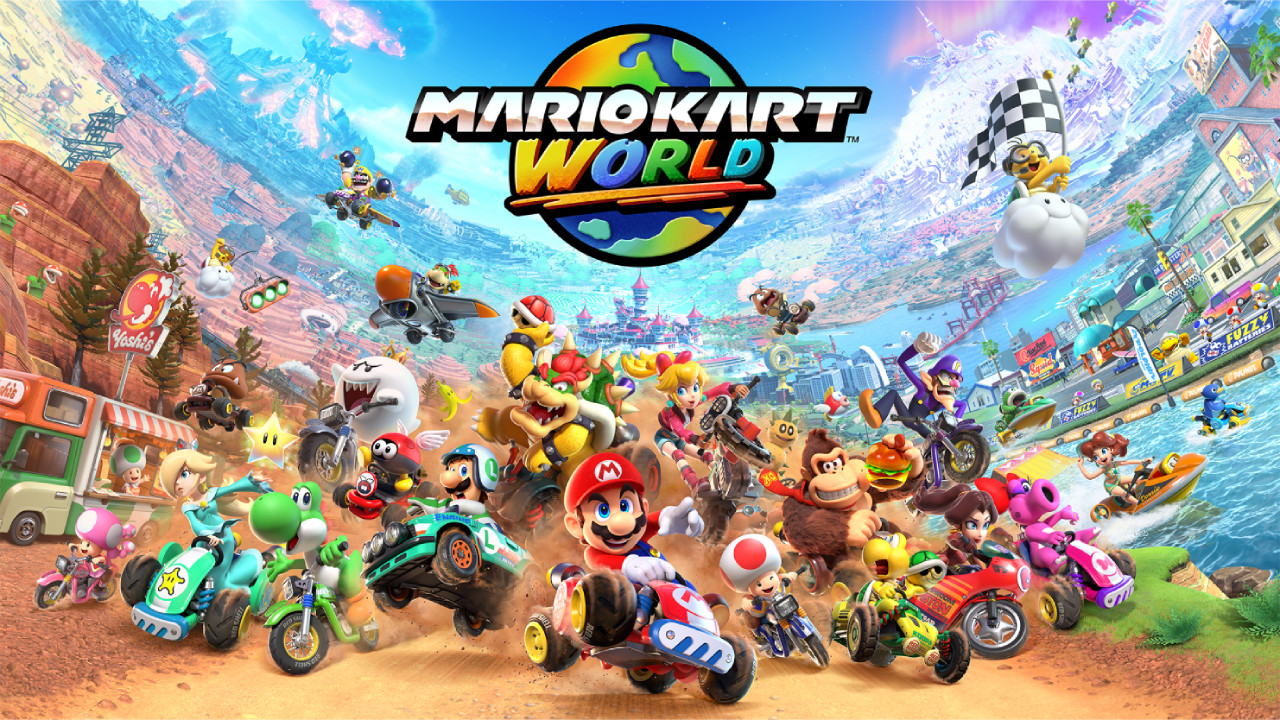
one of my big first impressions with Mario Kart World - and the thing that's going to follow you no matter which of its many facets you engage with - is that Mario Kart feels different for the first time in a shockingly long while. like, obviously Mario Kart 8 took up the last decade with upgrade after upgrade, but if you really want to start tracing it back, Mario Kart 7 felt pretty much in-line with what its console cousin would later do, and i might even stretch that era all the way back to 2008 with Mario Kart Wii sharing a pretty similar game-feel? i'm sure karting experts would gladly correct me on the subtle intricacies that set those three games apart, but from where i'm sitting, Mario Kart World feels like the first time since the mid-2000s that the series has really gone back to the drawing board rather than iterating on the same formula, which is wild when you think about the vast differences that'd separate games like Mario Kart 64, Double Dash!!, and DS.
that's not to say that the game is unrecognizable; this is still very much Mario Kart, with all its lovable quirks and tyrannical Blue Shells. the toolkit has been shuffled around and revitalized, though, with a bit of a 'bouncier' feel to the handling and some new tricks that lead to a more technical approach to peak performance. perhaps this says more about me and my skill bracket than it does about the game, but by the end of Mario Kart 8's tenure, i felt like that particular style of go-karting had been pushed to its logical limits, and just trying to drift as much as possible got a little tiresome. Mario Kart World, on the other hand, introduces some key new tools that open the game up to a lot more improvisation, and avoid the somewhat repetitive optimal play of previous games, at least so far.
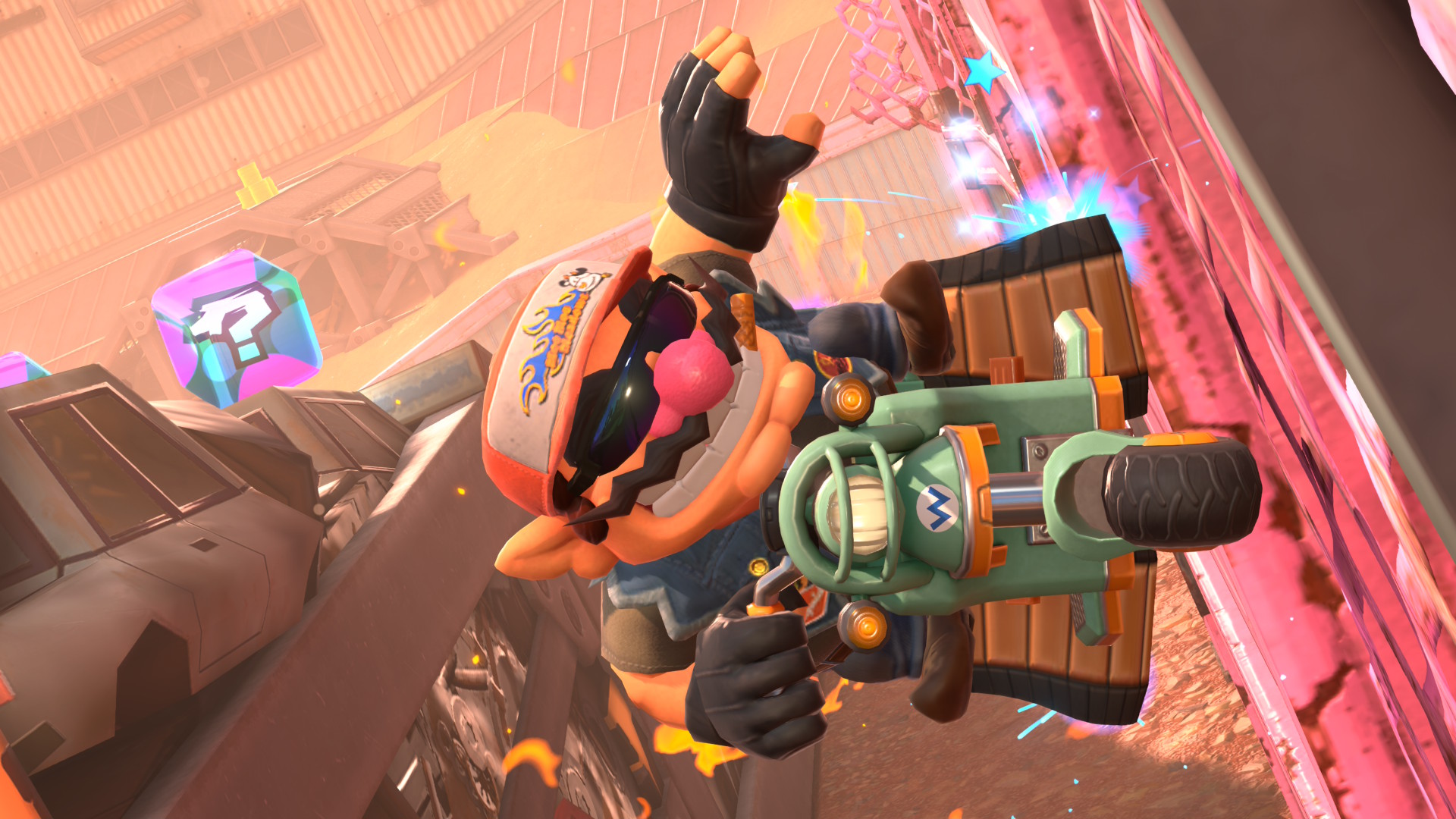
it took me a little while to get used to executing it in an actual race, and i do still think it feels maybe just a little too finicky to execute with the current control method, but the new 'Charge Jump' is the key element that opens up Mario Kart World's movement. at first glance, it just seems like a way to drift without drifting, building up mini-turbos while moving straight (tone-deaf to release this game during Pride, to say the least), but then you start realizing that you can flick the stick at the end to do a bit of a lateral flip, which then lets you hop onto nearby rails, and before you know it, you're chaining flips off of those together until you're suddenly riding along a wall and parkouring your way back down onto the course with a burst of speed.
combine these elements with a somewhat floatier drift that feels less universally important, and you have a game that feels wildly different from any other Mario Kart before it, with an incredibly high skill ceiling. i do worry that this might lead to online play becoming a little too intense for my liking - i've already seen some absurd clips of this game's techniques pushed to their limits, and i fear for the day when that becomes the standard archetype of player i'm put up against - but for couch co-op fun, i would say Mario Kart World already feels more interesting to compete in and improve at than its predecessors. adding a jump and designing courses around this type of free-flowing acrobatic movement really does bring the spirit of 3D Mario to the kart-racing side of the franchise more than ever before, and i'm here for it.

so, if that covers the Kart, and you can very visibly see the Mario operating it, what's up with that World? taking a page from all sorts of Forzas Horizon and Burnouts Paradise, Nintendo has eschewed the narrowly defined lanes of Mario Kart's past and opened the game up, with wider roads on tracks connected by all sorts of Mushroom Kingdom infrastructure. Grand Prix now takes players on the road from race to race, while the new Knockout Tour mode ditches even the loading screens between tracks for a non-stop end-to-end endurance run.
this added space between tracks - and the way it impacts the pacing of traditional Mario Kart - is definitely one of the most drastic changes this game has made to the formula, and already one of the most divisive. while you can use VS Races to enjoy classic three-lap karting, Mario Kart World is clearly designed first and foremost with these open world connections in mind, and isn't afraid to put those elements front and center. as someone who's been playing these games quite literally as long as i can remember, it's easy to bristle against such a big change, and i am a little split on how it's worked out, but i do lean towards thinking they've made the right call.
not all of these highway routes are winners, but then again, not every track in even the best traditional Mario Kart is going to be your favorite. when the concept shines, it really does shine; the Star Cup, for example, takes players on a tour of the snowy eastern section of the map, culminating in a race over the perpetually stormy waters of Wario Shipyard. in any other Mario Kart, a Grand Prix with three icy courses and a water level might feel a little bogged down and same-y, but the added context of the world between the tracks really makes it feel like its own little adventure, and i'd even say it helps emphasize how these courses all approach the same theme in very different ways.
it's also worth remembering the context of what Mario Kart has been, and why Nintendo EPD might have felt the need to take such a big swing. over the span of about ten years - and 96 courses, when all was said and done - Mario Kart 8 polished the classic three-lap design structure to a mirror finish. even all the way back at its original release in 2014, tracks like Mount Wario were starting to refine the idea of breaking the course down into legs of a journey rather than full loops around a circuit, and fans seemed to regard that type of experimentation as some of the most fun and innovative content in the game. if Mario Kart 8 Deluxe stands as the definitive article for a more classic Mario Kart experience, and runs just as well on a Switch 2, i think it's natural to want to try something different. "what if everything was kind of like Mount Wario" is, quite frankly, a pretty natural train of thought to follow if you're looking to solidly set your game apart as a new era of Mario Kart.
of course, Grand Prix and Knockout Tour are only two pieces of the big picture, and one of the game's big draws is the Free Roam mode, which feels... weird? it's weird. i like it, but it's weird.
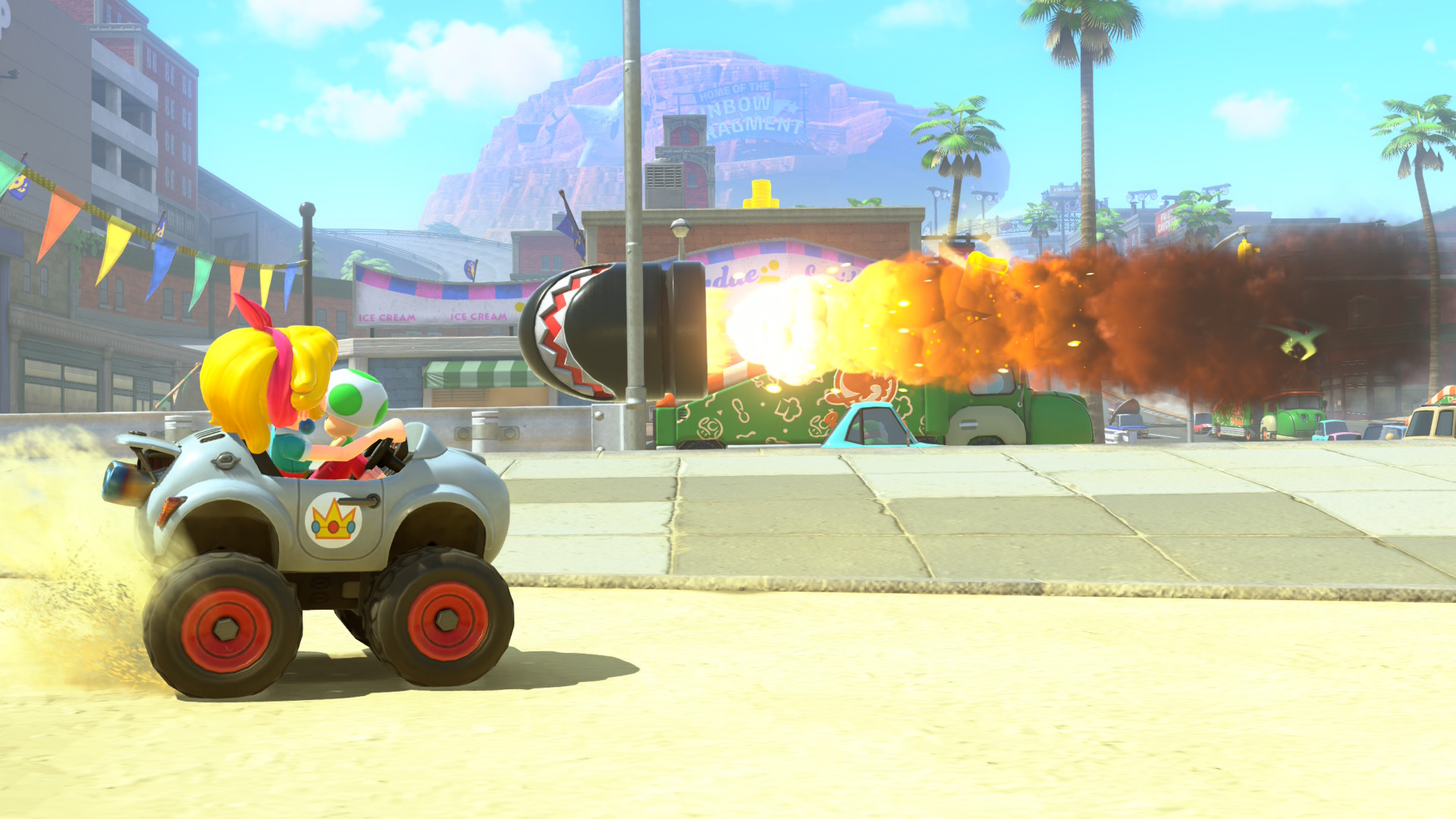
the way Mario Kart implies a world has always been really fascinating to me, all the way back to playing Double Dash!! as a kid and noticing how you could see the Daisy Cruiser way off the coast of the other courses. it's a very different take on Super Mario, one that clearly exists in conversation with the classic platformers but also exists at a distance from it, pulling together disparate elements until you have modern Toad cities side-by-side with the fantasy staple of a princess's castle, or the quite frankly irresponsible and frightening implication that Waluigi could own a stadium. Mario Kart doesn't really have narrative or continuity, but at the same time, each course really does feel like a place, no matter how absurd or nonsensical that place might be.
that type of enviromental storytelling that makes Mario Kart courses such weirdly captivating worlds despite their implausibilty really came to a head with Mario Kart 8, to the point where artists were modeling the entire inside of Mario's childhood home just to make one Game Boy Advance track more visually interesting. savoring that type of above-and-beyond detail became sort of a game unto itself, in some ways, and i think the team at Nintendo EPD latched onto that in a way that comes through very transparently in Mario Kart World. what if you could actually drive right up to all those details? what if instead of spending so much time polishing things up for players to appreciate at a distance, you made those environments a key part of the gameplay?
in a lot of really important ways, the titular world of Mario Kart World is a pretty astonishing accomplishment. i was hesitant about how well the concept could really come together, but i truly think they encapsulated the level of love and care that made past Mario Kart titles feel like such vivid settings, while also fulfilling that childhood power fantasy of telling Lakitu to take a hike so you can explore every nook and cranny. every track is full of little paths that lead you off the main course, whether that's to carve an unexpected route to another track or to let you get up close and personal with environmental details.
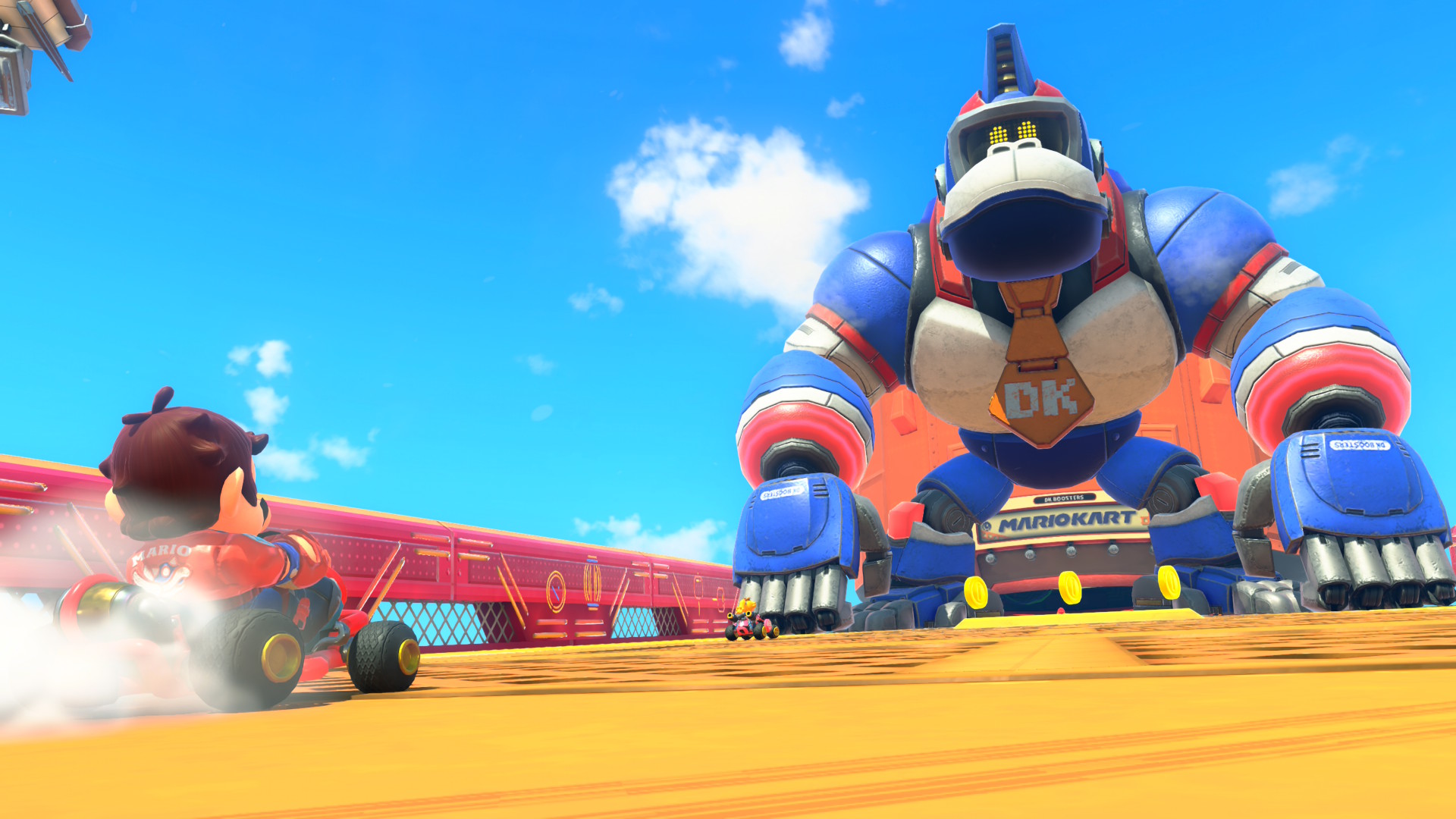
one of my biggest concerns with how an open world might impact Mario Kart was in how it'd split the difference between strangely grounded elements and larger-than-life setpieces. Mario Kart, to me, thrives on the delicate balance between the charmingly mundane Mushroom Bridges and the wild spectacle of a Rainbow Road, and i'm very happy to report that Mario Kart World has both in spades. a wide network of highways dotted with Toad houses and "Yoshi's" fast food joints connects vaguely real-world destinations like the skyscrapers of Crown City or the canals of Salty Salty Speedway, but head towards the far edges of the map and you'll find things like an ice cream town suspended high in the sky on giant popsicle sticks, a haunted theater where you drive into the screen on reels of film, or perhaps my favorite track in the game, DK Spaceport, which asks the important question of "what if Cape Canaveral was designed in tribute to the 1981 arcade classic Donkey Kong, complete with massive mechanical Kong menace". all of these weird, fantastical elements are still very much a part of Mario Kart World, and they've been worked surprisingly seamlessly into a setting where you can approach them from just about any angle.
likewise, the game's wide array of returning tracks have been given major facelifts that make them feel just as cohesive in the world as the fresh new designs. the familiar shapes of classic SNES courses have been placed amongst the backroads of the Mushroom Kingdom, tracks like Moo Moo Meadows find perfect niches amongst the wide open fields, and one of my childhood favorites, Peach Beach, has received a full-blown redesign combining its classic coastal waters with an expansive castle resort. if you love Mario Kart's history, then you're in good company, because the designers very clearly did too, yet at the same time, none of the old tracks feel incongruous with the fresh new idea of what Mario Kart is today; even the quite literally 'plopped down in the middle of the map' SNES Mario Circuit is contextualized as a sort of test track facility with quarterpipes and pit stop lanes.
that's all a lot about the design of the world itself, though; what do you do in it? that's a good question, and one that i think the game itself seems slightly hesitant to commit to an answer on. Free Roam isn't even listed alongside the other modes in the main menu, instead tucked into a corner when you fire the game up. part of that might be to flex the power of the Switch 2 - "look, just one button press and it instantly goes from demo mode to player-controlled open world driving!" - but it's also the first of many signs that Free Roam is a bit of an unconventional mode.
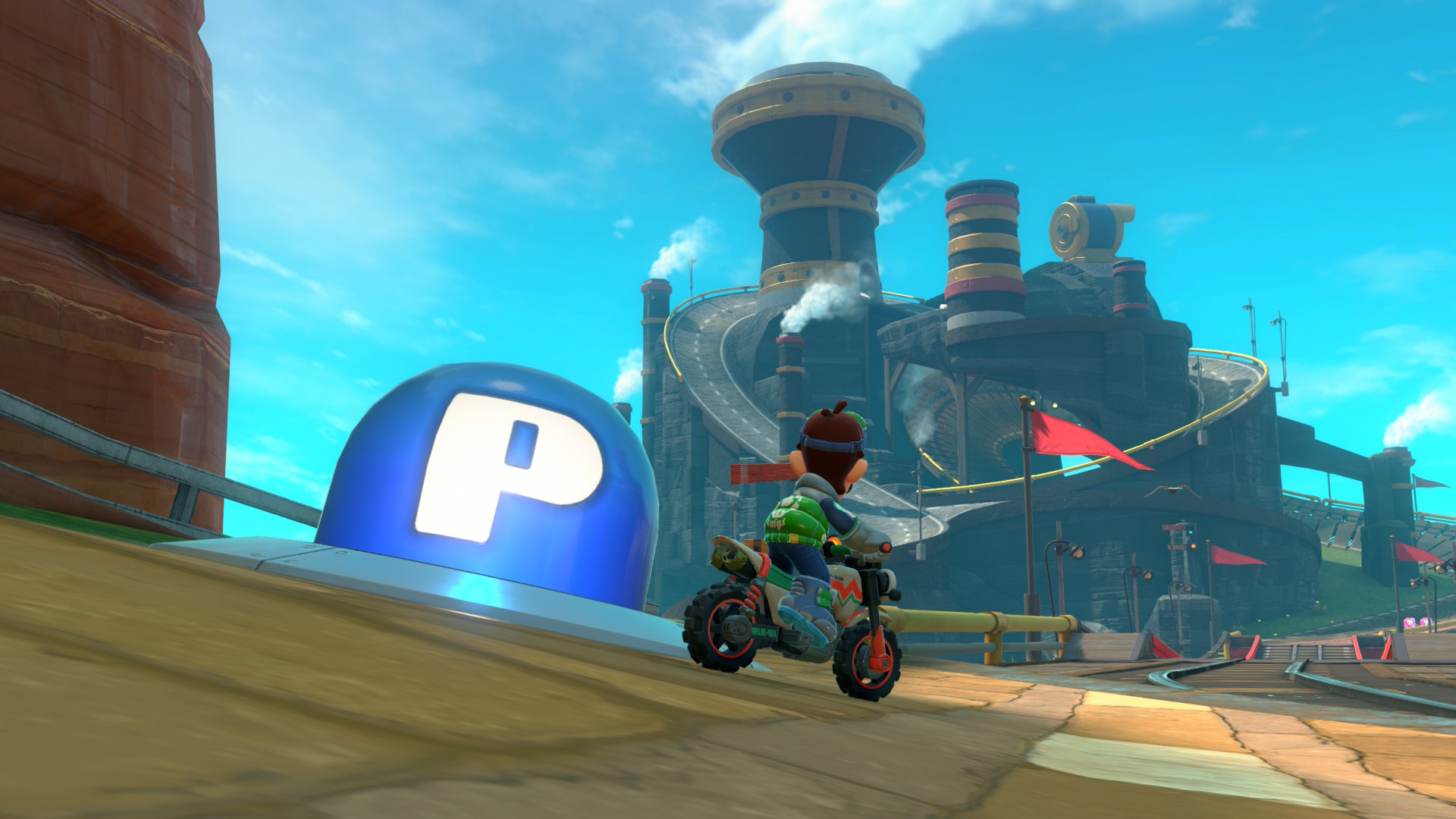
the good news is that the world is, indeed, full of stuff to do. on top of the joy of road-tripping through the Mushroom Kingdom, or the fun of testing a course for new shortcuts while 'off the clock', Free Roam also fills the open world with almost 400 P-Switch missions, and a handful of other collectible chases like Peach Medallions and ? Block Panels. these missions definitely feel like a Mario Kart take on modern Zelda's shrines, giving you bite-sized challenges on a tight timer. these range from creative little snippets like having a dinosaur pop out of the screen at Boo Cinema, to surprisingly tough technical challenges, which serve as a great way to get familiar with the fine details of how this game handles. i'd argue that even more than the 4K graphics or the seamlessness of the world, the P-Switch missions are one of the best showcases of what the Switch 2 can do better than its predecessor, by giving you a quick retry button that drops you back at the start of any challenge in the blink of an eye. trust me, you'll need it! a lot! and you'll be happy those load times are so short!
where things start to get a little dicier, and begin to feel like a bit of an afterthought, is everything surrounding these missions. the challenges themselves are great and i personally have no issue playing them for their own sake, just to see what kind of wild new thing will get thrown at me next, but the way they're presented and the rewards you get do feel decidely lackluster. no matter the mission or collectible, your reward is going to be a sticker, which you can decorate your kart with. that's one sticker per kart, often amidst a plethora of other baked-in decals, tucked away into some miniscule corner, or - most baffingly, given this is the game's only reward structure - not visible on certain vehicles at all.
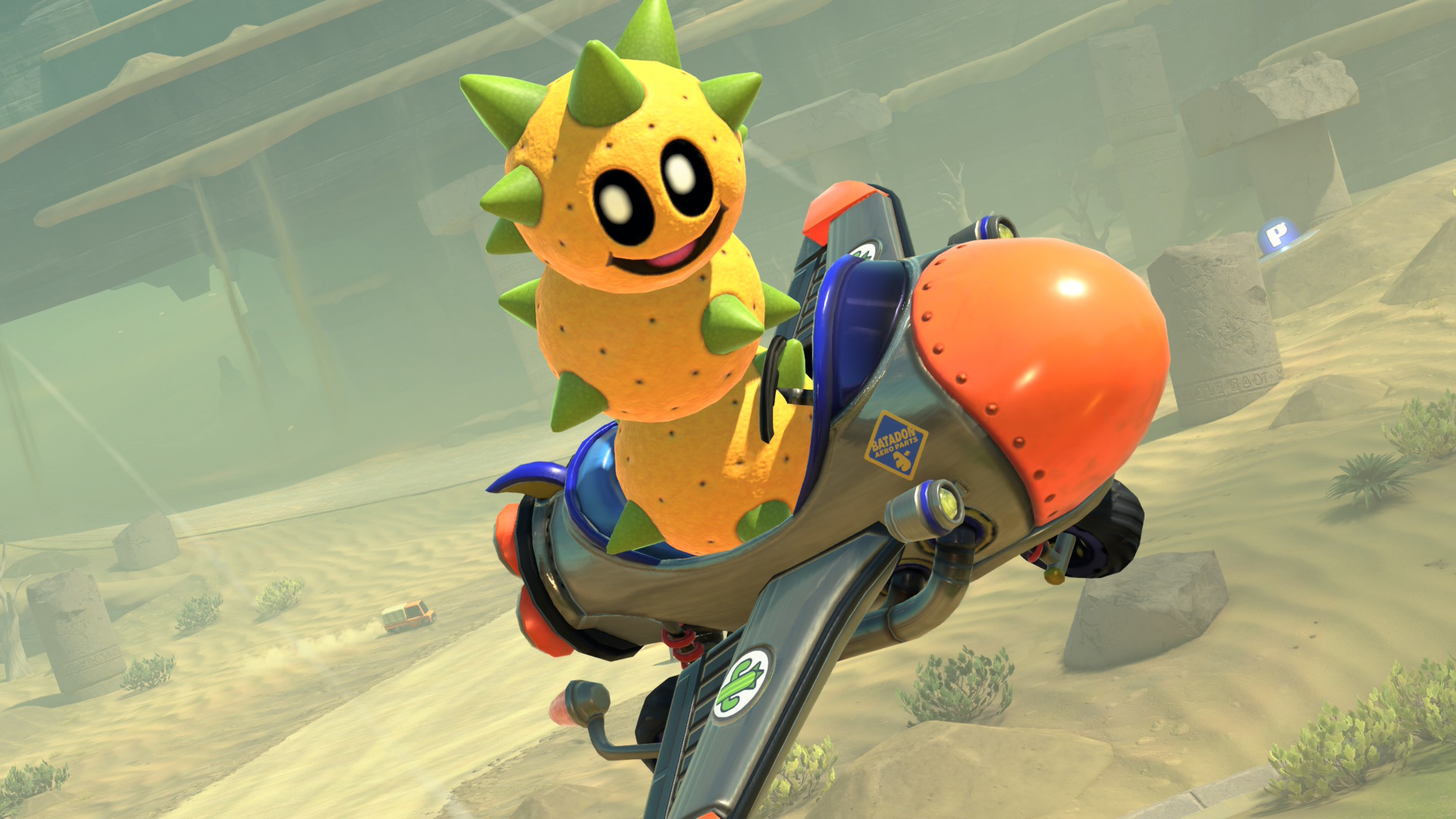
as the type of freak who loves all the little details in Mario Kart, i can appreciate the simple pleasure of collecting decals for fake brands like Shine Sprite Oil, or weird little signage of things like Wario saying "STOP GARLIC WASTE". however, even i'm capable of admitting i'm a freak for liking that, and that it can get a little deflating putting so much time into exploring the world and completing challenges just to receive yet another take on Toad Manufacturing's logo that i'll barely see on the side of my bike.
i can deal with a lack of extrinsic motivation, though; what's more unavoidably frustratingly is Mario Kart World's steadfast commitment to giving you as little information as possible about your progress and accomplishments. that "almost 400 challenges" number is something people had to figure out themselves, because Nintendo didn't bother telling anyone how many they put in, and the only number the game displays is how many you've already done, with no sense of how much more you have to go find. the only activity that has a definitive display of what you have and haven't done is the ? Block Panels scattered around each track, and even then, there's no way to be sure which ones you did without driving back to them and checking if they're still lit up.
if i'm trying to work backwards and figure out why the game's like that, i can just about see the case for this, barely. Mario Kart World doesn't present you with any mandatory tutorials that teach you about its new mechanics, so i wound up learning a lot about how jumps and wall-rides worked simply by dropping straight into Free Roam, examining a P-Switch mission, and determining that there must be some way to accomplish what was being asked of me. much like how these missions evoke Shrines, i think Mario Kart World might be trying to tap into some of that 'fuck around and find out' flow that Breath of the Wild had, launching a new Nintendo console with a game that doesn't hold your hand and instead surprises you with new possibilites that emerge naturally as you continue playing and learning.
at times, i do think this game hits that mark, and even when it doesn't, i still admire the sheer scope of what they've made, both with their world design and the missions that fill it. ultimately, though, with the whole mode segmented off from the rest of the game and the rewards feeling somewhat flat and slapped on (as stickers are known to be), the game seems a little shy about some of its best contents. to bring it back to the Zelda comparison, they seem to have approached the P-Switch missions a bit like the Korok seeds. there's a ton of them, so don't bother counting them all, and the rewards aren't worth writing home about, so just do however many you feel like and ignore the rest! the issue is that while the Korok seeds all used the same handful of puzzles, the things in Mario Kart World often feel a lot cooler, more bespoke and worth pursuing than those trappings would imply. with how much effort went into these missions, i'd like to know where i can find more of them, rather than wandering around aimlessly trying to find the cool things the team's made.
this unfortunately isn't the only element where Free Roam - and Mario Kart World as a whole - grapples with poor quality-of-life features. each region of the Mushroom Kingdom has its own lovingly rendered local Dash Food that unlocks new costumes for your racers, but these costumes are distributed unevenly, and it's often unclear what meal will unlock what new look. a cavalcade of proper Mario freaks have been added to pad out this game's 24-player races, but unlocking them involves multiple layers of sheer luck, being on the receiving end of a rare new item and just hoping it applies a new effect instead of turning you into Nabbit for the 20th time. the wildly elaborate real-time 3D minimap lacks any sort of compass, making it unnecessarily difficult to find your bearings if you stray too far from the major courses.
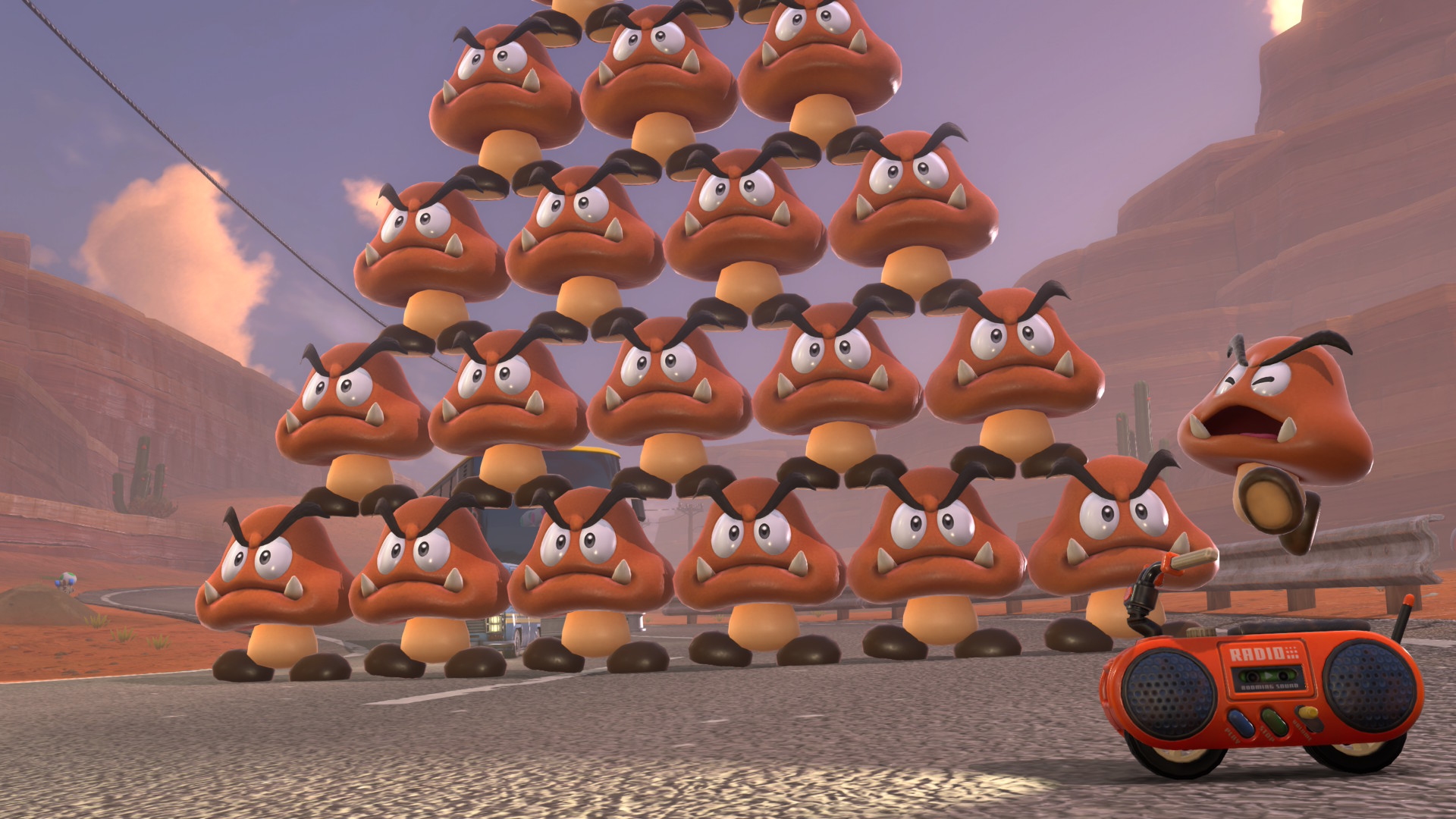
out of all of the high effort additions to this game that are hard to fully appreciate thanks to iffy design, the soundtrack might be the worst offender. Mario Kart World features hundreds of pieces of music, ranging from new tracks to Mario Kart classics and even diving into the wider Mario franchise, with everything from WarioWare to Mario Paint turning up. everything's been given absurdly robust new arrangements, often with live bands putting their own new spin on some of the best music in the entire medium. whether it's Baby Park done up as an EDM club banger, or Super Mario 64's Slider reinterpreted as third wave ska, or just something ambient and lo-fi like Dolphin Shoals, the soundtrack to this game is on par with Super Smash Bros. Ultimate as a love letter to video game history, and... you just kind of have to hope you hear it?
no way to choose what music you'll roam or race to, no way to listen to individual tracks, not even so much as a corner pop-up letting you know the name of the song so you can go look it up later. in Free Roam, music just kind of plays randomly, sometimes attuned to the particular environment you're in if you're lucky. on top of all this, the audio mixing seems to actively downplay all these tracks, putting the rev of the engine front and center. i know i can go looking for the music on my own time on YouTube - and i've seen more than one person cynically float that the lack of any options around this game's soundtrack might have something to do with Nintendo's in-house music app - but music is a key component of any game's aesthetics, and for them to have put so much effort into this game's soundscape only for it to almost actively undermine it feels like a major missed opportunity. if the stickers feel lacking as a reward structure, and there are other, much cooler things that are either a hassle to unlock or actively gated off from the player... it seems like there's a pretty clear solution to these issues!
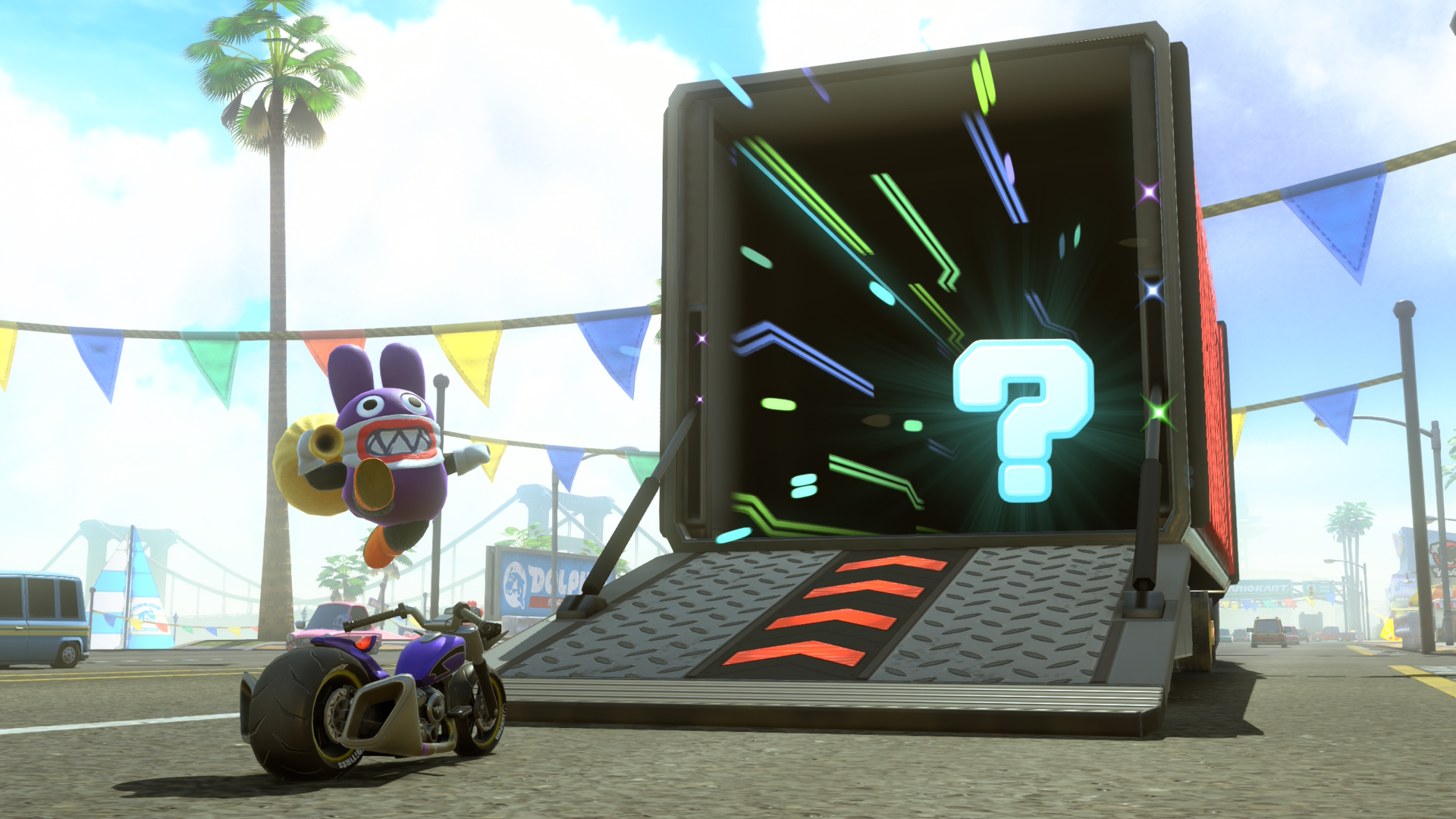
there's a blurry line between a game's design ethos being free-flowing or aimless, and i think Mario Kart World's highs and lows come from the moments where it either nails that balance or fumbles it. for a game where creating an open world informs so many other choices, it's ironically the part where you're allowed to truly explore that world openly where i end up feeling most conflicted about things. on the one hand, it's an amazingly crafted world that feels alive and thriving with detail, filled with interesting things to do, but at the same time, it seems to actively recoil away from giving that world a structural backbone.
for as negative as i might sound, i do actually think there's something to be said for video game worlds that lack that type of structure. one recent game that came to mind for me in all of this was Pokémon Scarlet - a comparison that might sound extremely frightening to a lot of people, but i assure you is being brought up in a nice way - and its approach to open world design. when i wrote about that game, one thing i mused about was the types of emergent activities that might come about when you have weirdly elaborate movement mechanics in an open world without much pre-designed stuff to do outside of Pokémon's usual RPG frameworks.
don't get me wrong, i think that Pokémon Scarlet's shortcomings held it back from taking on that sort of secondary appeal, and Mario Kart World is unquestionably a more well-designed game with less of a divide between its actual primary goals and this more loose, improvisational level of enjoyment, but the same ideas do come to mind when i'm playing Free Roam. even when you're not "doing something" in a video game, in the sense that you're not participating in guided activities or earning some kind of reward, i think a good set of basic mechanics can make even aimlessness fun in its own way.
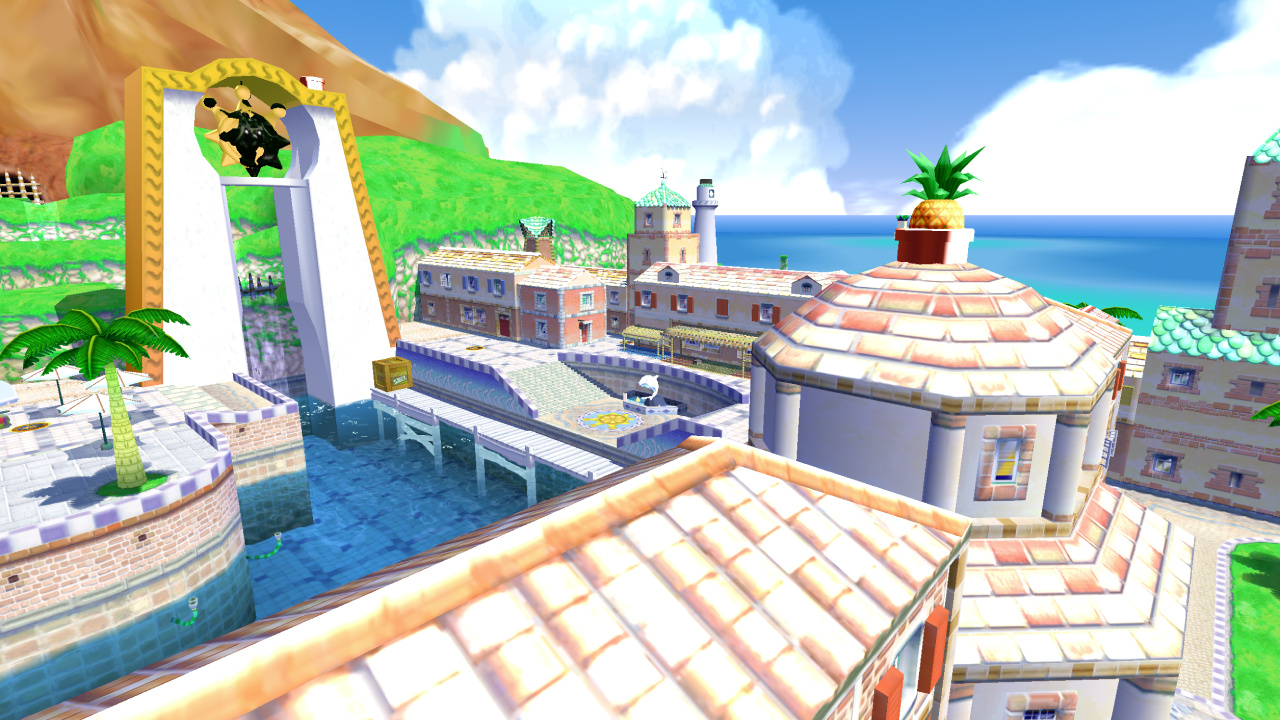
maybe it really is just the fact that Mario Kart was such a formative game for me, but whenever i find myself frustrated with the way Free Roam is handled in this game, i find myself reeled back a little bit by remembering what some of my favorite Nintendo games as a kid were, and the ways i played those games. going back and looking at it, Delfino Plaza from Super Mario Sunshine seems a lot more quaint than i remember, but the experience of screwing around and getting Yoshi to weird rooftops stuck with me far more distinctly than any of the actual levels of that game. the way Double Dash!! implied a bigger world was part of what captivated me long before i knew how to actually 'succeed' at Mario Kart, so for as many gripes as i could throw at this game, there is something more ephemeral to its appeal; the simple joy of going off the track and seeing what they've made, just for its own sake.
so, long story short, i don't think it's inaccurate to say Free Roam is pretty good. i would say that it falls a little short when it comes to bringing its best aspects together, and could use some serious polish when it comes to quality-of-life features, but at the absolute worst, it's a charming, relaxing way to engage with the game that also happens to have a lot of interesting bite-sized challenges for Mario Kart aficionados to stumble into. normally, this would be an incredibly predictable way for me to wrap things up; it is a time-honored HYPERFIXT tradition to go "well, i talked a lot about what's wrong with it, but i kind of like it anyways, so all's well that ends well". like i said at the top, though, i'm doing this partially out of a sense of privilege and responsibility, and i do feel obligated to do the boring grown-up work of addressing the elephant in the room.
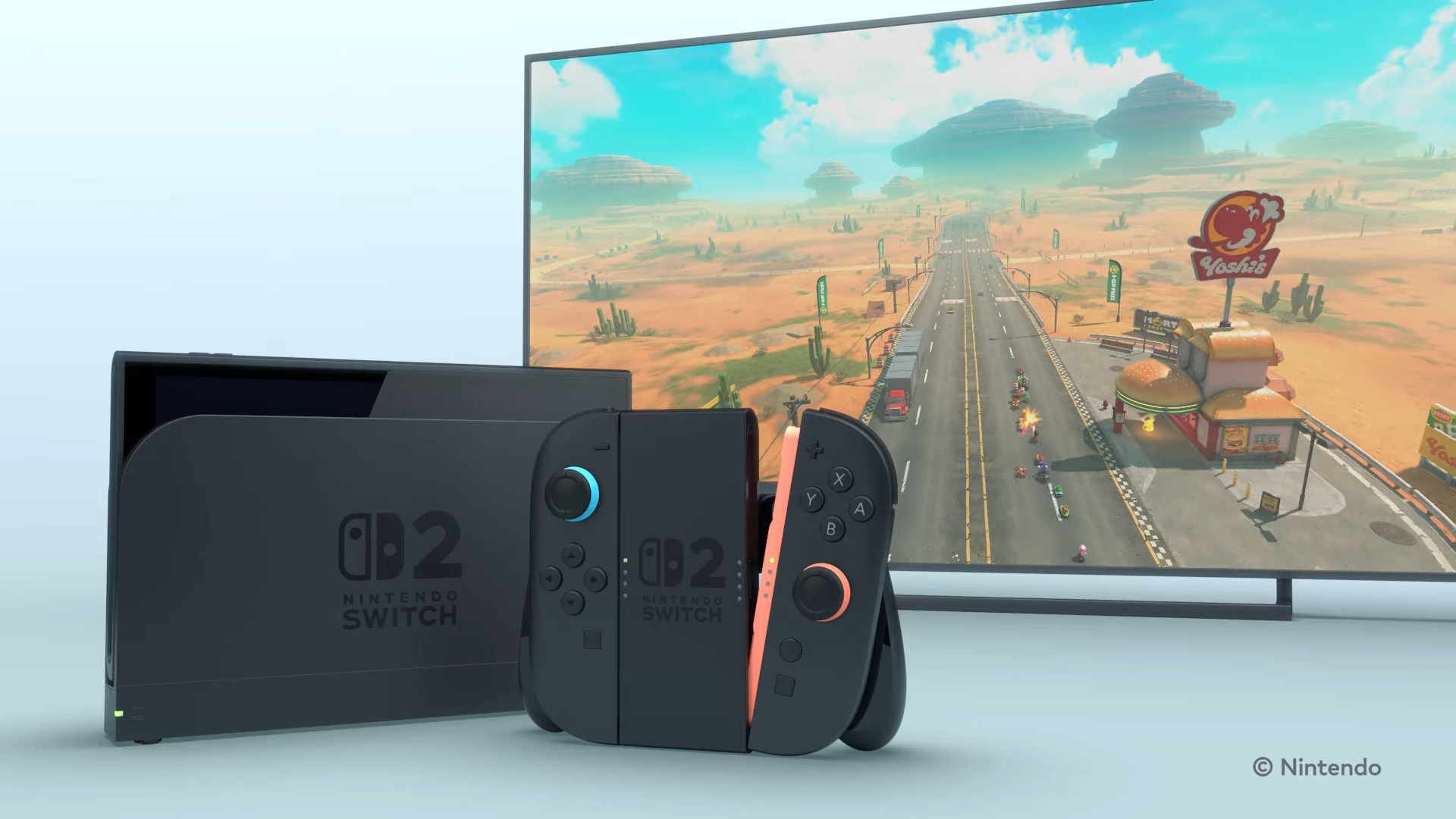
Mario Kart World is an $80 video game for a $450 console; you can bump that cumulative cost down a bit if you go for the bundle, but the unavoidable fact of the matter is that playing this game, as of this writing and probably for the foreseeable future, involves a notably large finanical commitment upfront. in a media landscape where it felt like people still hadn't finished making their cases for or against the merits of video games costing $70, Nintendo has opted to step in and leapfrog ahead, with the vague promise that people would understand why Mario Kart World required such a premium cost once the game was in their hands.
i am not necessarily fundamentally opposed to games costing more - i have long been of the opinion that at the current pace of the medium, something's gotta give, whether that's the scope of projects or the costs for consumers. i really don't think there's a one-size-fits-all answer to these issues, and i definitely err towards giving developers some amount of grace about the rising costs associated with creating games that i love. it's hard to ignore that this is a prominent inflection point for this stuff, though, with an incredibly major headliner franchise also receiving an out-of-the-ordinary jump forward in pricing.
in a vacuum, i can sit here all day and tell you that for all its strange shortcomings, Mario Kart World is a very good game. it's the most fresh and inventive the series has felt in years, and it draws upon Nintendo's expertise in both crafting fantastic worlds and fantastic ways to move within them. i can forgive Free Roam's issues with the understanding that it's just something extra on top of the traditional Mario Kart package, and with the opinion that even with its issues, i still think what they've made is worth engaging with, even if that means just casually road-tripping your way across the map or creating your own fun with friends online.
Mario Kart World doesn't exist in a vacuum, though. i'm having fun, but can i confidently say that people should go out of their way to acquire a whole new system to play it? judging from Nintendo's rather quiet 'let the game speak for itself' confidence, am i meant to understand that Free Roam is the key factor that bumps this game's pricepoint up a full $20, and if so, do i need to come down harsher on its shortcomings? or is Free Roam really just a side dish they were able to make because they'd already decided on the open world thing, meaning i then have to ask if Mario Kart as a platonic ideal has been refined enough to justify that leap?
i was lucky enough to be able to split the cost with other people who might have cared even more strongly than me about playing Mario Kart, but that's me and my situation; is there any sort of broader yes-or-no answer i can give, or is it really just within these narrow circumstances that it all happens to works out? if it's a privilege for me to be able to deliver some hands-on impressions to friends who might not be in a position to get a Switch 2 - or might even be using my takes as a barometer if they're on the fence and considering such a big purchase - is it an abuse of that privilege to say "the game is lacking in key areas that you will absolutely notice, but just don't worry about that and have fun anyways"?
this is all getting a little heady for a Mario Kart review, and i definitely need to remind myself i'm not Lord of Switch 2 Mountain, doling out objective measurements of value for any huge swath of people waiting with bated breath. this is one dweeb on the internet talking to, at most, maybe a dozen other dweebs on the internet. this does all seriously cross my mind when it comes to distilling my personal experiences into something that i'm going to put in front of people, though, and however much responsibility i have as one dweeb on the internet, i want to respect the privilege of that mantle. heavy are the hands that type the blog.
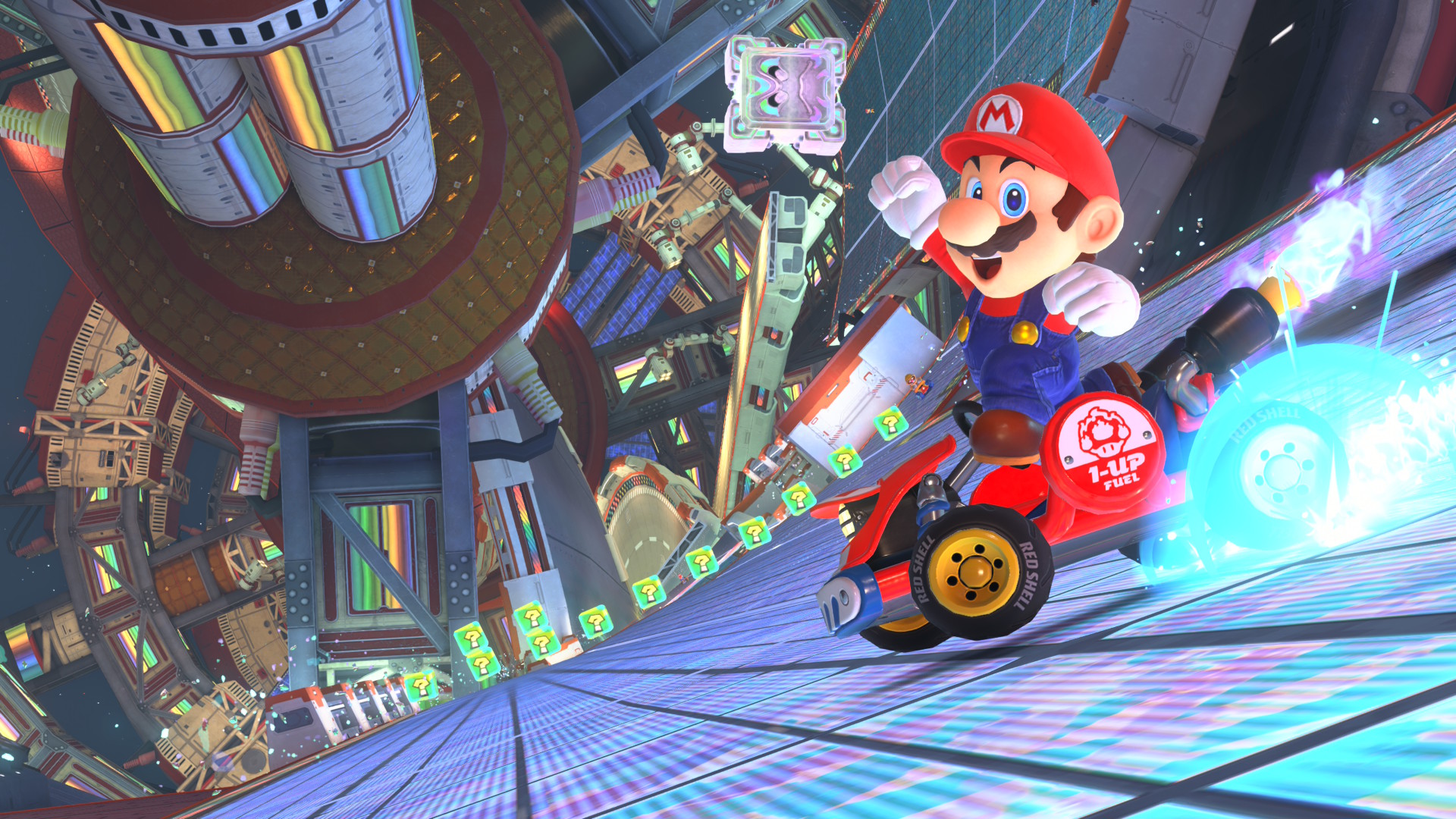
if all i've got are my takes, and i'm stepping back from trying to claim any sort of definitive expertise on whether or not Mario Kart World is "worth it" or not? i like the game. i think it builds on what Mario Kart has been in some very smart ways, and captures both the fun of racing that's been there all along and the promise of exploration that i've always wondered about since i was a kid. it's far from perfect, and i certainly hope that Nintendo takes advantage of the technical flexibility of modern games to smooth over some of its rough edges, but there's a lot of fun to be had here, whether it's chasing down what's been laid out for you, or in going off-road, both literally and spiritually, to carve your own path. what you do out there - and what you do with all of this - is really up to you.


